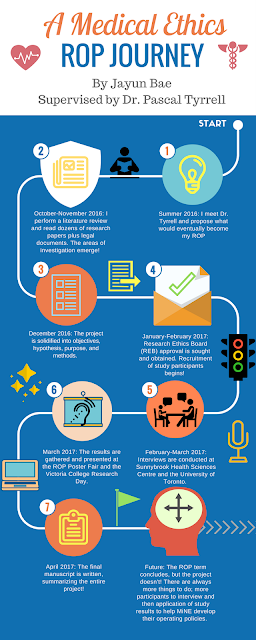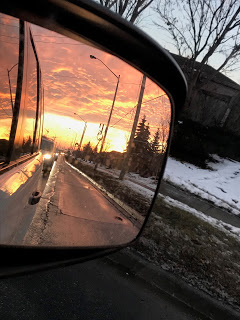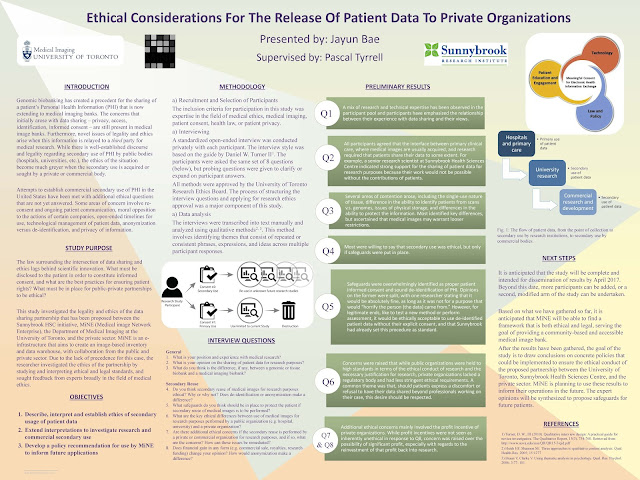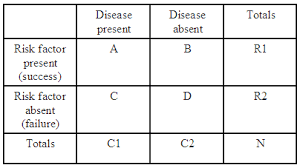ROP299 2017-2018: A Medical Imaging Journey from a Humanities Perspective
My name is Samantha Santoro, and I am completing my second year in the English and Biology majors at the University of Toronto, St. George. A rather unconventional combination, when reviewing past students of Dr. Tyrrell’s lab. I was a 2017-2018 Research Opportunity Program (ROP) student in Dr. Pascal Tyrrell’s lab, and my work chiefly consisted of evaluating the internal vessel wall volumes of carotid arteries in a particular cohort of patients provided by the ongoing prospective CAIN study. My ROP was in the field of Medical Imaging. I am the co-president of the student club known as Watsi, with the main chapter based in San Francisco. I am also a special contributor to the Rare Disease Review, along with volunteering at an amalgamation of charity walks and fundraisers.
My ROP project was a turbulent experience – although that word is typically associated with a negative connotation, I regard my ROP299Y1 as one of the most humbling, interesting, and educative experiences that I have had thus far – most definitely not negative. However, to say everything went smoothly would be discrediting the lessons I learned from when things were not idyllic and smooth. My project, as aforementioned, statistically analyzed data provided by patients part of the CAIN study (an analysis that could not have existed without Dr. Tyrrell’s generous and unwavering support). My study determined that patients who were found to have IPH, or what is known as intraplaque hemorrhage, when I analyzed their MRIs, were also found to have increased vessel wall volume. This conclusion is incredibly significant, as IPH is a surrogate marker for atherosclerosis and could potentially be an indicator for patients at risk of future cerebrovascular events (namely, ischemic stroke). As strokes are currently the number three killer in the U.S and Canada alone, and heart disease number one, having a potential indicator for patients at risk of stroke would greatly benefit clinicians in their practice, as well as patients themselves.
As aforementioned, studies similar to my own are currently underway by the Canadian Atherosclerosis Imaging Network, furthering the important research in this field. The VBIRG (Vascular Biology Imaging Research Group) was the lab in which I primarily worked throughout the course of my ROP, at Sunnybrook Hospital. Moreover, I also worked on systematic reviews and reports outside of the focus of my project, in the fields of medical ethics and AI in the radiology workplace – both of which were opportunities provided to me by Dr. Tyrrell, and both of which were incredibly valuable experiences, allowing for me to broaden my knowledge of certain areas of medicine and science that are developing and expanding.
Although my project was littered with its own respective difficulties – a substantial number of drafts throughout each step of the program (more than I had ever made, even being an English student); a reluctant, but later fulfilling, acquaintanceship with the post-processing software VesselMass; and several late nights learning about the field of statistics – it is in light of these difficulties, and at present having overcome them throughout my ROP, that I remember Dr. Paul Kalanithi’s words in his memoir When Breath Becomes Air: “It occurred to me that my relationship with statistics changed as soon as I became one”. He, too, had studied Biology and English. I may not have played a lead role in the statistics I had been working with, but I can now say that understanding what they meant and how they were formulated has generated a deep respect in me for the field of statistics.
My poster was on display at the 2018 Research Opportunity Undergraduate Fair. Special thanks to Mariam Afshin, my supervisor at Sunnybrook Hospital; Bowen Zhang, for answering each question I had while at Sunnybrook; John, and the rest of the lab team; and Dr. Pascal Tyrrell, for answering my email last February and holding my interview on the same day as my Chemistry exam. Never before had I met such an – in a word – outstanding professor, and I dare say that I will never meet one like him throughout the rest of my academic journey.
Samantha Santoro
MiVIP meets AI…
Well, I think it was inevitable. My data science lab has slowly crossed over to the dark side into the world of Machine Learning and Artificial Intelligence.
Let me apologize for being MIA for so long. Life has been pretty hectic these past months as I have been building the MiDATA program here in the Department of Medical Imaging at the University of Toronto. The good news is that the MiVIP program will now be inviting students to participate in machine learning and artificial intelligence in medical image research.
This summer will include the launch our our MiStats+ML program where we will have students from the department of statistical sciences, computer sciences, and life sciences all work together on ML/AI projects in the MiDATA lab.
Stay tuned as we ramp up and get back to some our previous threads like MiWORD of the day…
See you in the blogosphere,
Pascal
Lessons Along the Way
 |
| https://betakit.com/startupcfo-explains-the-long-windy-road-to-a-closed-funding-round/ |
review articles – all until I was confident enough to evaluate articles on my own. For me, the key to learning a complex subject was to build on foundational concepts and keep things as clear as possible. As Einstein once said: “If you can’t explain it simply, you don’t understand it well enough”.
Fund grant. The lessons for me here? The importance of seeking expert help where appropriate, and that being resourceful can pay off (literally)! Finally, I valued our strong team culture, without which none of this would have been possible.
blogosphere,
Afsaneh Amirabadi & Team
“Hour of Code… Part Deux” at the University of Toronto
What hour of code? What code?
The Hour of Code is a global movement reaching tens of millions of students in 180+ countries. The purpose is to to demystify “code”, to show that anybody can learn the basics, and to broaden participation in the field of computer science. Please see here for more info.
I belong to Code.org a non-profit dedicated to expanding access to computer science, and increasing participation by women and underrepresented students of color.
What is the purpose of this event?
To engage young minds and help them see the exciting possibilities computer programming can offer them in their future careers.
Who is coming?
Over 100 students (grades 7 to 11) from Central Toronto Academy (TDSB), St Francis Assisi and St Ignatius of Loyola (TCDSB).
Who will be engaging them (so far)?
University of Toronto:
MiDATA (Data Science unit from the Department of Medical Imaging)
*Prof Pascal Tyrrell – Director, Data Science
*Prof Anne Martel – Medical Biophysics (Machine Learning)
*Dr Mariam Afshin – Research Physicist
Department of Medical Imaging
*Dr Alan Moody – Radiologist and Chair of the Department
Department of Statistical Sciences
*Prof Paul Corey – Senior Biostatistician
*Chris Meaney – Biostatistician
Department of Computer Science
*Prof Steve Engels
Industry:
IBM Watson Health and Merge Healthcare
*Aditya Sriram – Developer, IBM Watson Health Imaging
Microsoft (Big Data and Analytics)
* Sage Franch – Microsoft Canada
SAS Canada
*Mark Morreale – Lead, Academic Program
Community:
Ladies Learning Code – Yaa Otchere
Industry Support:
Google
Tyrrell lab students and Computer Science undergraduates will be acting as ambassadors.
Where and when will the event be held…exactly?
University College, University of Toronto
15 King’s College Circle
Toronto, Ontario
Interested in participating? Contact me at pascal.tyrrell@utoronto.ca!
See you all there,
Pascal Tyrrell
The Ram-ifications of Risk
|
|
Surgery
|
No Surgery (control)
|
Totals
|
|
Retained
thumb function
|
7
|
6
|
13
|
|
Lost thumb function
|
3
|
4
|
7
|
|
Totals
|
10
|
10
|
20
|
So what’s up with the Dodge Ram ad (I am actually a F150 guy myself)? Well I just thought it went well with ramifications of risk. Cheesy I know. But who knows maybe it will help you to remember…
Indranil Balki and Pascal Tyrrell
The Ratios of Risk With a Zip!
With summer here, I think it’s time that we continued our discussion on risk. No, I’m not talking about the dangers of your favourite adventure sport… but then I just got back from a trip to Costa Rica as part of the Canadian delegation for the Gateway to Trade project and I, of course, went ziplining! Awesome.
It’s been a few months so I recommend catching up on Risky Business – Is it all Relative? and Happy New Year and Enjoy some AR&R.
Before we get started I want to introduce a student of mine, Indranil Balki, who has agreed to come aboard and help me write this blog. Life is busy for me and I feel bad that I can’t post as much as I would like. So look to find Indranil signing off with me at the bottom of these posts.
When we last left off, we were interested in the idea of comparing risks – how many times more likely is it for a smartphone user to develop smartphone thumb than for a non-smartphone user?
We touched on one way to compare the two groups in the last post, by finding the risk difference A/(A+B) – C/(C+D). But to answer our question, we need a ratio. It turns out that this is called (helpfully) a risk ratio, or relative risk (RR). The RR is given by A/(A+B) divided by C/(C+D). A RR basically compares the risk in the exposed (smartphone owners) and unexposed conditions.
For example, let’s say that 20% of smartphone users developed smartphone thumb and 10% of non-smartphone users developed smartphone thump. Then the RR is 2, meaning that you are twice as likely to get the disease if you own a smartphone than if you don’t.
Well wasn’t that an elegant way to compare the risks between two groups? As you might have guessed, a RR of 1 shows no difference in risk between the groups, and an RR > 2 or <0.5 is usually considered statistically significant.
So let’s say you meet a friend at school and he finally reveals that he has smartphone thumb (don’t worry, it’s not contagious – I think!). Since you’ve been following this blog, you immediately wonder, what’s the probability that he has a smartphone? To answer this reverse question, it turns out that you technically need what is called an odds ratio (OR). The OR is comparable to the RR if the prevalence of the disease is low. But it is a slightly different way to compare risks.
Given that you have smartphone thumb, the odds that you had the exposure are given by the probability that you had a smartphone (A/A+C), divided by the probably that you didn’t have it (C/A+C). This simplifies to A/C. Similarly, the odds of exposure in those without smartphone thumb is B/D. The odds ratio then, is calculated by dividing these 2 odds. OR = A/C ÷ B/D. An OR of, say 3, tells us that there’s a 3 times higher chance your friend has a smartphone than he doesn’t.
Well, that might have been a tough post! Take some time to think about it, have a gander at some ziplining in Costa Rica here and don’t spend too much time on your smartphone…
See you in the blogosphere,
Indranil Balki and Pascal Tyrrell
A Medical Ethics ROP Journey with Jayun Bae
 |
| Jayun Bae – ROP299Y 2016-17 |
uncovered throughout the project. It quickly became clear that the answers could not be found through an examination of precedence or legal documents, because many of the research actions that would take place (specifically involving private organizations) fell in the grey area between what was legal and what was ethical. For example, the Personal Information Protection and Electronic Documents Act (PIPEDA) and Personal Health Information Protection Act (PHIPA) are two guidelines for organizations to follow when handling patient data – but neither are able to clearly and positively dictate how this partnership should operate.
Dr. Tyrrell for the guidance and mentorship. The project is not yet completed, so I am looking forward to continuing the study beyond the scope of the ROP. Please have a look at my poster from the 2017 ROP Research Day below:
MRI, Statistics, Carotid Arteries, and 1000 Cups of Coffee with George Wang
 |
| GeorgeWang – ROP299Y 2016-17 |
Happy New Year and Enjoy Some AR&R…
 |
| Or Attributable Risk Reduction… |
First let me wish you all a fantastic New Year! Last year was crazy and I think this year is looking like it will be more of the same…
So in a previous post called Risky Business: Is It All Relative? we started talking about risk. We agreed that in lay terms a risk is generally associated with a bad event. However, a risk in statistical terms refers simply to the probability (usually statistical probability value between 0 and 1) that an event will occur, whether it be a good or a bad event.
We also defined the risk of “smartphone thumb” as the number of new cases of smartphone thumb (the outcome) in a given period of time divided by the total number of people who own a smartphone (the exposure) and are at risk. This was called the cumulative incidence or absolute risk. Now what if we wanted to compare this risk to people who did not receive a smartphone for their birthday or Christmas for that matter? Let’s look at the results in a contingency table:
Let’s say 20% of smartphone users develop smartphone thumb whereas only 10% or non-smartphone users do. The RD is then equal to 10% (0.2 – 0.1 *100). The reduction in the chances of experiencing smartphone thumb who own a smartphone is the AR% which in this case is 50% (0.1/0.2*100).

For now, decompress listening to “Under my Thumb” by the Rolling Stones. Classic…
See you in the blogosphere,
Pascal Tyrrell








